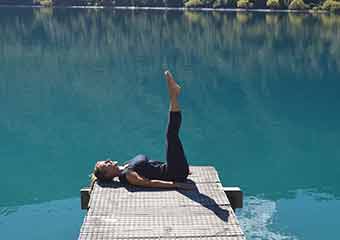
Pat Zanin
Pat 4 Pilates Yoga Fitness
Tips When performing Pilates
Focus areas
To ensure correct performance of all Pilates exercises, it is essential that you are able to achieve "Neutral Spine" (optimal posture) and activate your deep stabilising muscles correctly (Transversus Abdominis and pelvic floor). Learning these Pilates principles prior to commencing Pilates exercises and applying them to each exercise is vital to ensure maximal benefit.
Neutral Spine
Neutral Spine refers to the position whereby your spine is in optimal posture and alignment . Generally, neutral spine can be obtained by ensuring the following:
- There should be a straight line from your ears, to your shoulders, to your hips
- Your shoulder blades should be back and down slightly
- Your upper back relatively straight
- Your chin should be tucked in slightly with your eyes and nose facing forwards.
- There should be a slight curve in your lower back
- Think about maintaining a tall, long spine with minimal effort
Achieving Neutral Spine
The following 3 steps can be undertaken to achieve neutral spine. Before you commence these 3 steps, begin lying on your back with your knees bent, your feet shoulder width apart and your arms by your side.
- Lower back and pelvis
Tilt your pelvis forwards and backwards without moving your ribs, so your lower back arches fully and then flattens fully. Then try to maintain a pelvic and lower back position half way between these two extremes (i.e. a slight curve in the lower back). This is neutral spine for the lower back and pelvis.
- Upper back and shoulder blades
Pull your shoulder blades back and down slightly, whilst maintaining a flat upper back against the floor. This is neutral spine for the upper back and shoulder blades.
- Neck
Tuck your chin in slightly and ensure your eyes and nose are facing directly upwards. This is neutral spine for the neck.
These principles can be applied to achieve neutral spine in any position (e.g. Standing and Four Point Kneeling ) and should be integrated into all Pilates exercises.
Transversus Abdominis (TA)
The transversus abdominis muscle is the deepest of the abdominal muscles and is one of the main stabilizers of the lower back and pelvis. The orientation of the transversus abdominis muscle is similar to a corset, whereby it wraps around your lower abdomen and attaches to your lower back. When the transversus abdominis muscle contracts it acts like a back brace stabilising your spine and supporting your lower back. It is an integral component of core stability and should be activated with all Pilates exercises.
Activating your Transversus abdominis (TA)
- Begin lying on your back in neutral spine
- Slowly draw the section of your abdomen situated below your belly button upwards and inwards "away from your belt line"
- Breathe normally
- Your rib cage should remain relaxed and should not elevate during this process.
- You should be able to feel the muscle contracting if you press deeply 2cm in from the bony prominence at the front of your pelvis.
- Hold this muscle at 20 – 30% of a maximal contraction
If you are unsure as to whether you are contracting your transversus abdominis muscle correctly, the best way to check is with a physiotherapist using real time ultrasound. This allows direct viewing of your transversus abdominis muscle and is the most effective way to teach correct transversus abdominis activation.
Pelvic Floor
The pelvic floor muscles sit deeply at the base of the abdomen and are primarily responsible for controlling bowel and bladder function. In addition, the pelvic floor muscles act to stabilise the pelvis and lower back and are an integral component of Pilates exercises. Pelvic floor retraining is particularly important for patients suffering lower back pain, women before and after pregnancy, athletes with osteitis pubis, as well as those who experience incontinence.
Activating your Pelvic Floor
- Begin lying on your back in neutral spine
- Slowly contract the muscles in your saddle region by lifting them upwards. These are the same muscles used to stop the flow of urine when you are going to the toilet.
- Breathe normally
- Hold this muscle at 20-30% of a maximal contraction
- Try activating your pelvic floor and transversus abdominis simultaneously